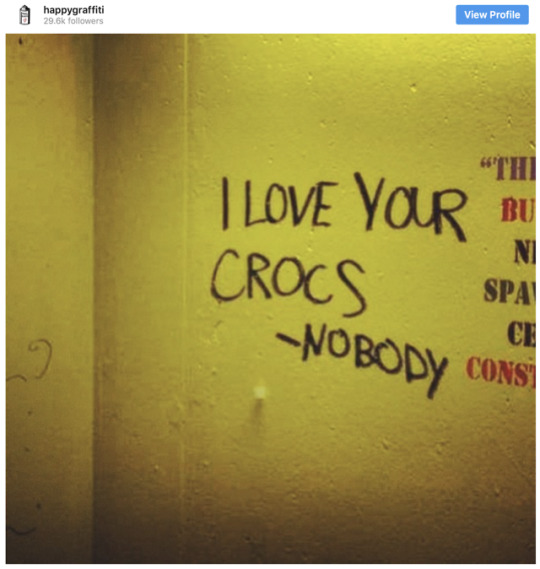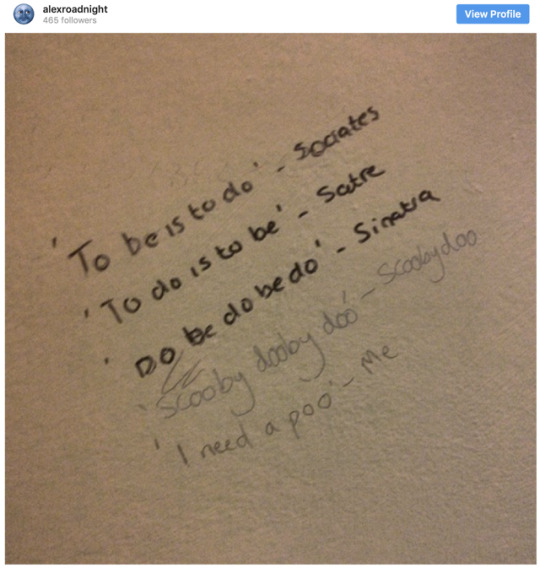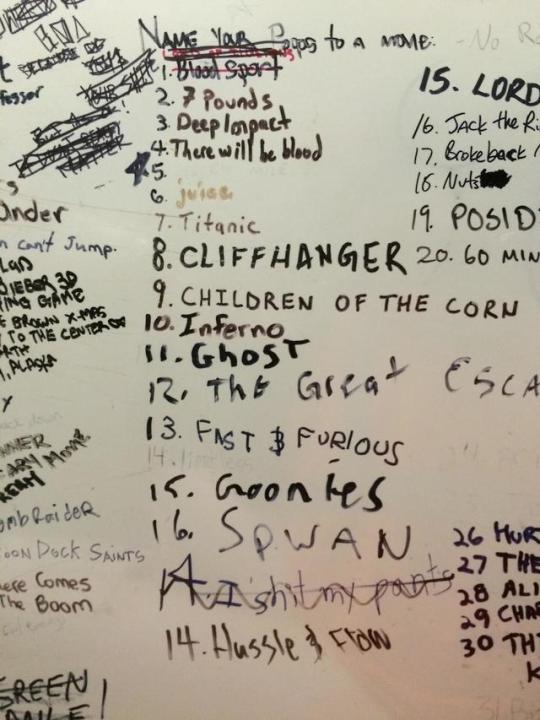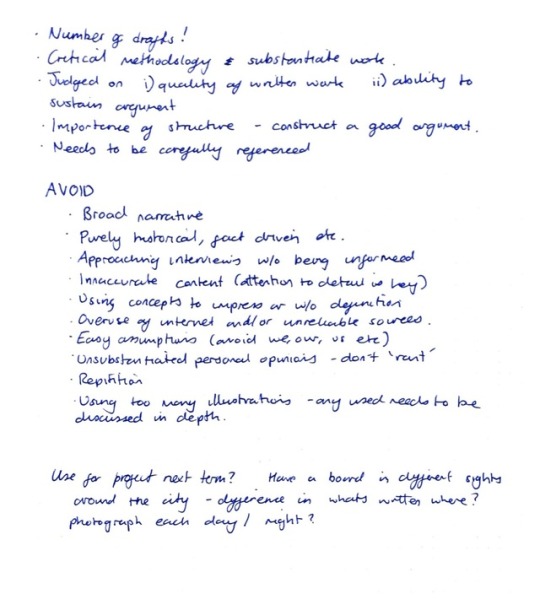Don't wanna be here? Send us removal request.
Photo



Dive Bar, Hull - https://www.facebook.com/pg/DiveHull/photos/?tab=album&album_id=468768680347740&ref=page_internal [11/12/19]
0 notes
Photo

http://peterflaig.blogspot.com/2009/09/mens-bathroom-above-urinal-dinosaur-bar.html
10/12/19
0 notes
Text
Bibliography 22/10/19 (not checked fully for formatting)
ABEL, E., 2010. Signs of the times the visual politics of Jim Crow. Berkeley: University of California Press.
ALLEN S. MARQUEZ, C., D. JAMES, H. and D. MAMAOAG, M., 2018. Understanding Gender Differences on Motivations and Literary and Linguistic Devices in Graffiti. World Journal of Social Sciences and Humanities, 4(3), pp. 177-188.
BAGNALL, R.S., 2011. Everyday writing in the Graeco-Roman East. Berkeley: University of California Press.
BARTHOLOME, L. and SNYDER, P., 2004. Is It Philosophy or Pornography? Graffiti at the Dinosaur Bar-B-Que. The Journal of American Culture, 27(1), pp. 86-98.
BECK, J., 2014, November 14,. Behind the writing on the stalls. The Atlantic.
DUNDES, A., 1996. Here I Sit - A Study In American Latrinalia. Kroeber Anthropological Society Papers 34, , pp. 91-105.
DUNDES, A. and BRONNER, S.J., 2007. The meaning of folklore the analytical essays of Alan Dundes. Logan: Utah State University Press.
FERRIS, F.S., 2015. "Poof! a'm heppily saving the Lord...": Multimodality and evaluative discourses in male toilet graffiti at the University of the Western Cape. African Identities, .
FERRIS, F. and BANDA, F., 2018. Recontextualisation and reappropriation of social and political discourses in toilet graffiti at the University of the Western Cape. Stellenbosch Papers in Linguistics Plus (SPiL Plus), 55, pp. 27-45.
KLAUNE, F., January 22, 2005-last update, Shithouse Poet. Available: https://www.urbandictionary.com/define.php?term=Shithouse%20Poet [August 17, 2019].
KTENA, N., April 25, 2018-last update, Toilet graffiti: Turns out, men and women do it differently. Available: https://www.bbc.co.uk/bbcthree/article/0694ce0c-2b2e-46c7-a09d-53e238662e03 [August 17, 2019].
LUXTON, E., September 26, 2017-last update, How to Stop Vandalization of Bathroom Stalls. Available: https://careertrend.com/how-5982842-make-metal-bending-jig.html [October 22, 2019].
MATTHEWS, N., SPEERS, L. and BALL, J., 2012. Bathroom Banter: Sex, Love, and the Bathroom Wall. Electronic Journal of Human Sexuality, 15.
MORRITT, R.D., 2010. Stones that speak. Newcastle upon Tyne: Cambridge Scholars.
Ö CENGIZ and C CENGIZ, 2017. Independent area toilet: The analysis of the toilet.
OTTA, E., 1993. Graffiti in the 1990s: A Study of Inscriptions on Restroom Walls. The Journal of social psychology, 133(4), pp. 589-590.
SKOGLUND, P., LING, J. and BERTILSSON, U., 2015. Picturing the Bronze Age. Oxford ;: Oxbow Books.
ST. JEAN, PETER K. B., 2007. Pockets of Crime : Broken Windows, Collective Efficacy, and the Criminal Point of View. Chicago: University of Chicago Press.
WALLACE, R., 2005. An Introduction to Wall Inscriptions from Pompeii and Herculaneum: Introduction, Inscriptions with Notes, Historical Commentary, Vocabulary. Place of publication not identified: Bolchazy Carducci Publishers.
WHITING, S. and KOLLER, V., 2007. Dialogues in solitude: the discursive structures and social functions of male toilet graffiti.
0 notes
Text
Behind the writing on the stalls – Beck. J, The Atlantic, November 21, 2014
Toilet graffiti also offers an interesting contrast to the way people typically behave in the bathroom. The unspoken rules of keeping to oneself, not making eye contact, and avoiding talking to strangers, all contribute to a sometimes-tense environment with the goal of shifting focus away from what’s actually happening behind stall doors. But the graffiti on the stall doors does not ignore it one bit. It crudely acknowledges and pokes fun at what we all go to the bathroom to do, and flouts the politeness surrounding it as well. “Sorry,” you say when you reach for a paper towel at the same time as someone else. “Go fuck yourself,” says the bathroom graffiti.
0 notes
Text
Is it philosophy or pornography? Graffiti at the dinosaur Bar-B-Que – Bartholome. L, Snyder. P, The journal of American Culture, Volume 27, Number 1, March 2004 – Page 86
As part of the dining experience, customers are encouraged to write their opinions about the food or anything else on the graffiti laden walls of the restaurants bathrooms.
A cornucopia of both social dogma and sexual come-ons … one may enter the restroom and discover the philosophy of Nietzsche, the location of Kilroy, or political statements tinged with feminism
Unlike several previous studies, that the content and amount of graffiti does not vary between the restrooms of males and females. Given the encouragement and free and equal opportunity for expression, women produce the same amount of explicit graffiti as men.
Robert Reisner suggests that the first examples of graffiti date back to primeval times. Drawings of bison and deer found in European caves demonstrate prehistoric man and women’s need to proclaim their existence.
Graffiti changed significantly during the 1960’s, perhaps as a result of the social unrest that erupted in this country. The evolution of the civil rights movement, the women’s movement, the anti-Vietnam war movement…
0 notes
Text
Bathroom Banter: Sex, Love, and the Bathroom Wall - Matthews. N, Speers. L, Ball. J, Electronic Journal of Human Sexuality, Volume 15, August 17, 2012
nine local bars in a medium-sized Midwestern city. The researchers coded 1,201 inscriptions for elements tied to evolutionary psychology and previous research on graffiti. The results indicated that males, compared to females, composed more sexual, homosexual, and presence identifying graffiti. Additionally, males drew more stand-alone images and authored more graffiti overall. However, females authored more romantic, interactive, and insulting graffiti. Many of the findings are largely in line with evolutionary psychology and some reaffirm the results found by previous research.
The finding that females authored more insults concurred with evolutionary psychology but disagreed with previous research into graffiti (e.g., Burner & Kelso, 1980; Green, 2003). This finding identifies a key strategic difference among the sexes. Females are more likely than males to use verbal/textual relational aggression to derogate competitors. However, males composed more message indicating physical presence than females. Marking physical presence is akin to marking territory and thus, proclaiming resources and warding off competitors. In rationalizing this difference, it appears that males indirectly intimidate rivals and aim to impress mates using graffiti. Females, on the other hand, do not attempt to ascend above their competitors; rather, they use insults to bring their opponents down.
0 notes
Text


New river studios, London. Instagram #toiletgraffiti accessed 7/10/19
0 notes
Text
Graffiti in the 1990s: A Study of Inscriptions on Restroom Walls Otta, Emma The Journal of Social Psychology, 01 August 1993, Vol.133(4), pp.589-590
Graffiti were located from men's and women's restrooms in 10 university buildings in Sao Paulo, Brazil, during a 2-month period in 1990. The data were compared with Wales and Brewer's (1976) study of graffiti in U.S. high schools and Barbosa's (1985) study, which used data from various buildings, all in Brazil.
Each graffito was classified in one of the following 20 categories: racial insults, sexual insults, general insults, sexual humor, general humor, sexual request, romanticism, politics, drugs, religion, morals, names, hygiene, personal problems, grammatical corrections, scatological remarks, AIDS-related remarks, sexuality, philosophical remarks, and miscellaneous remarks.
Of the 518 graffiti collected, 424 (81.8%) were in men's restrooms, and 94 (18.1%) were in women's restrooms. Barbosa (1985) found that graffiti were equally prevalent in men's restrooms in pubs, bus stations, and schools. Wales and Brewer (1976) reported that 88% of the graffiti in American high schools were found in the girls' restrooms, and only 12% were found in the boys' restrooms.
Most of the graffiti in this study concerned sexuality (18.9%). The proportion of graffiti that concerned sexuality in addition to the categories of sexual request, sexual humor, sexual insults, and AIDS-related remarks was 41.1%. This finding is consistent with the data of Barbosa (1985), who reported that graffiti on restroom walls are most often related to sexuality. AIDS-related graffiti were found in the present research, but were not, of course. found in Brazil in the early 1980s or by Wales and Brewer in their study (1976) of graffiti in American high schools.
The second highest proportion of graffiti concerned politics (15.0%). Barbosa (1985) found political graffiti in university restrooms more often than in other buildings. Of the 20 categories of graffiti, sexuality and politics were those found most frequently in men's restrooms (18.4% and 15.4%, respectively) and in women's restrooms (21.3% and 14.9%, respectively). Subsequently, there were clear gender differences regarding the content of graffiti. Romanticism (9.6%), personal problems (9.6%), and morality (7.4%) were more prevalent in women's restrooms, whereas sexual request (9.2%), general insults (8.2%), and sexual insults (8.2%) were more prevalent in men's restrooms. These gender differences were statistically significant, p < .05.
Barbosa (1985) and Wales and Brewer (1976) also reported that graffiti with romantic content were found more frequently in women's restrooms than in men's restrooms. This anonymous restroom testimony bears witness to the importance of emotional relationships for women (Mellen, 1981).
All the categories of graffiti were present at some level in the men's restrooms, whereas racial insults, references to drugs, and references to AIDS were absent from the women's restrooms. Women's graffiti were more conservative and conventional than men's graffiti; morality and religion represented 11.6% of the content of the women's graffiti but only 2.1% of the men's.
REFERENCES
Barbosa, G. G. (1985). Grafitos de banheiro: Literatura proibida [Restroom graffiti: Forbidden literature]. Sao Paulo: Brasiliense.
Mellen, S. L. W. (1981). The evolution of love. Oxford: Freeman.
Wales, E., & Brewer, B. (1976). Graffiti in the 1970's. Journal of Social Psychology, 99, 115-123.
0 notes
Text
Ferris, Fiona S ; Banda, Felix, "Poof! a'm heppily saving the Lord...": multimodality and evaluative discourses in male toilet graffiti at the University of the Western Cape, African Identities, 02 October 2015, Vol.13(4), pp.243-261
Toilet graffiti as a literacy practice, although a very common sight, is still largely neglected in academic literature. A study by Gebhard, Kinsey, Martin, and Pomeroy (1953) on toilet graffiti and sexual desire sparked some academic interest in this area. A few theorists have thus far written short articles on toilet graffiti, but comprehensive research on toilet graffiti as a literacy practice in area of communication and media studies still lacks. The few research articles that do exist are from the disciplines of Sociology, Psychology and Anthropology. These studies are usually focused on the amount of toilet graffiti written, graffiti and sexual references, gendered differences in toilet graffiti or the arising themes (Wales & Brewer, 1976; Dundes, 1966; Farr & Gordon, 1975; Farnia, 2014; Flores & Sechrest, 1969; Gebhard et al., 1953; Lomas, 1973; Olowu, 1983; Pennebaker & Sanders, 1976; Wolff, 2010 etc.). In the field of communication, limited research exist on graffiti on the level of semantics and as a genre (Adams & Winter, 1997; Green, 2003). Bates and Martin (1980, p. 30) assert that very little has been written on toilet graffiti in terms of its content or the characteristics of the people who write them. Ferris (2010) laments that in South Africa there is even a bigger dearth of studies on graffiti focusing on students writing on toilet walls. – pg 2
0 notes
Photo




https://www.buzzfeed.com/ailbhemalone/times-toilet-graffiti-knew-you-better-than-you-knew-yours?sub=2695893_2970471
0 notes
Photo



1. https://imgur.com/ipzcxIm
2. https-//www.reddit.com/r/bathroomstallpoetry/
3. https-//i.redd.it/x18x8wdtze011
0 notes
Photo

https://www.reddit.com/r/funny/search/?q=shithouse%20poet&restrict_sr=1
0 notes
Text
https://www.urbandictionary.com/define.php?term=Shithouse%20Poet – Urban Dictionary: Shithouse Poet
Widely-acclaimed anonymous author of infamous wit and wisdom written on the stalls and walls of many bathrooms. The "Shithouse Poet" is believed to actually be a number of different individuals acting in nearly every state of the United States. Much to the chagrin of janitors, the Shithouse Poet leaves his nuggets (pardon the pun) of wit and wisdom in the form of well-crafted prose and poetry through various means in batrhooms throughout the U.S.A.
Some examples: "They scrub these walls to stop my pen, but the Shithouse Poet strikes again. The erased words are all my life. I'll next engrave them with my knife." And... "Here I sat all broken hearted. Tried to shat, but only farted. So today I took a chance. Now I say I shit my pants. Tomorrow I decide my fate. I'll borrow a quart of Kaopectate."
0 notes
Text
Dunes, A and Bronner, S - Meaning of Folklore : The Analytical Essays of Alan Dundes, 2007
“Here I Sit” also dealt with one of his experiences—going to bathrooms in Berkeley, where his folkloristic antennae picked up an abundance of written lore. He noted that they were much more common in facilities for men, rather than women, raising gender questions about the praxis of writing verses and sayings he called “latrinalia,” to distinguish it from the more general term “graffiti” for any wall markings… Ever since Dundes’s latrinalia essay was originally published, it has been cited as a benchmark interpretation of bathroom graffiti. See Gonos, Mulkern, and Poushinsky 1976; Stocker et al. 1972; Birney 1973; and Longenecker 1977. While the above citations are mostly of men’s facilities, for an exemplary look at a woman’s bathroom as “community,” see Gordon 2003. For other interpretative essays on folklore using Dundes’s scatological theses, see Fleisher 1981; Mechling 1984a and 1984b; Carroll 1987; Klein 1993; and Bronner 2007. – pg 353-4
B Here I Sit: A Study of American Latrinalia
A ny American male who has ever had an occasion to enter a public bathroom such as one found in a railroad or bus terminal has surely observed at one time or another one of the many traditional inscriptions found on the walls of the facilities. 1 In some quarters, e.g. in the rest rooms of some bars and cafés, one finds the custom has been institutionalized in that a small slate and an accompanying piece of chalk are hanging on the wall. This allows individuals to write freely and at the same time it saves the establishment the expense of continually repainting walls. Despite the widespread distribution of these inscriptions and despite the fact that many of them are demonstrably traditional, one looks in vain for extended collections of published texts and for any rational discussion of them or the practice of writing them. Most histories of the water closet (e.g. Pudney, Reynolds, Wright) do little more than recognize that such traditions exist. Typical is the remark made by poet John Pudney, author of The Smallest Room , who bothers to say (1954:130), “I must here resist the temptation urged on me by several men of letters to quote more freely from this poetry of the smallest room.” Certainly there can be no doubt as to the antiquity of the genre. In the chapter devoted to latrines of John G. Bourke’s classic Scatalogic Rites of All Nations , one finds references to the obscene poetry written in Roman latrines (1891:136). What little evidence is available in print does attest to the age and international spread of this popular form of written folklore. – pg 360
The classic study of the form in America was made by Allen Walker Read who privately published it in 1935 under the euphemistic title , Lexical Evidence from Folk Epigraphy in Western North America: AGlossarial Study of the Low Element in the English Vocabulary . The title page of this eighty-three page monograph announced that the circulation was restricted to students of linguistics, folklore, abnormal psychology, and allied branches of the social sciences. Professor Read’s term “folk epigraphy” raises the question of what to call bathroom wall writings. T he term graffiti is too broad in that it includes all kinds of inscriptions and marks placed on walls. Moreover, the walls may be any walls, not just bathroom walls. Professor Read included in his compilation everything he saw on walls during an extensive sight-seeing trip made in the western United States and Canada in the summer of 1928. Much of his material is traditional in form only, but not content. The various homosexual rendezvous requests with listings of dimensions and telephone numbers are clearly the traditional in form and are surely worth studying as indicators of one of the obvious functions of men’s rooms in a culture which forbids homosexual activities. However, the specific content of these assignation attempts is often idiosyncratic. The folklorist is primarily interested in those mural inscriptions which are traditional in both form and content. T hus while he or she may record the hapax logomena or one-time occurrences, he or she is more concerned with those which have multiple-existence, that is, those which are found with almost exactly the same form and wording in many different places. Obviously, a one-time occurrence may become traditional in time, but the vast majority of the nontraditional graffiti are much too localized to diffuse easily. For the traditional inscriptions, I propose the term latrinalia. This is preferable, I think, to the closest thing to a folk term, “shithouse poetry” inasmuch as not all latrinalia is in verse or poetic form. Pg 360-1
As one writer has put it (Reynolds 1943:171–172), “Stereotyped and crude, our lavatory inscriptions are the measure of our social fixations; and that enterprising anthropologist who is said to be collecting photographs of them in all parts of the world should reveal more of the truth than all of the bombastic historians who will so soon be clothing our grotesque society with dignified phrases and political stercorations, representing its present antics as studied movements, to be explained in terms of high principles and rational conduct.” So then let us proceed with our essay in hard core ethnography! – pg 361
One of the few places where dirt may be displayed and discussed in American culture is the bathroom, private and public. Bathrooms, generally speaking, are status symbols and not infrequently houses are measured in part by the number of bathrooms they possess. – pg 362
It is in the public school bathroom (termed boys’ and girls’ “basement” at my secondary school in Pawling, New York, though the rooms were not located in the basement) that important social interactions take place. Boys meet there to discuss the problems of the day while girls similarly go there to gossip. It is in many ways a place of comparative freedom from the normal restraints imposed by the T heses on Feces 363 adult world. The necessity of some sexual exposure no doubt contributes to the bathroom’s role as a place of sanctioned license. It is in public bathrooms, particularly men’s rooms, that one finds latrinalia. T he variety of latrinalia forms includes: (1) advertisements or solicitations, normally of a sexual nature; (2) requests or commands, often concerning the mechanics of defecating or urinating; (3) directions, which consist of false or facetious instructions; (4) commentaries, either by the establishment or by clients; and (5) personal laments or introspective musings. These categories are not hard and fast and they are not necessarily mutually exclusive. A sampling of each of the categories should serve to illustrate the nature of American latrinalia. T he majority of advertisements are probably not traditional in that individuals simply write their own names and telephone numbers. Furthermore, in view of the paucity of published materials, it is difficult to ascertain whether or not a number of items have appeared elsewhere. Typical “want ads,” which may or may not be traditional, include:
1. 2. For a good blow job, call 777 2024 Bill, don’t call, it’s me, Bob.
2. I’m big. 9” long, 3” round, and ready to go. (In another hand) How big is your prick?
In view of the nontraditional content of most latrinalia advertisements, I will proceed to the more common traditional category of requests or commands. The following are usually placed near men’s urinals:
3. Don’t throw cigarette butts in the urinal— It makes them soggy and hard to light.
4. Please do not throw butts in the urinal. Do we piss in your ash trays?
This is strikingly similar in style to the private swimming pool sign which reads:
1. We don’t swim in your toilet Please don’t piss in our pool.
The pool sign reflects, of course, the fact that Americans do in fact urinate in swimming pools (just as American infants urinate in their baths)! A large number of urinal latrinalia specifically ask for care in aiming the stream of urine. Typical examples of this “toilet training” tradition include:
5. We aim to please you aim too please
6. It is our aim to keep this place clean. Your aim will help.
These are often written by the management. A common request urges men to stand close to the urinal to reduce the chances of spillage.
7. Stand up close. The next man might have holes in his shoes.
8. Stand close, the next person may be barefooted.
9. Stand up close. The next fellow may be a Southerner And be barefooted. (Camp Maxey, Paris, Texas, 1945)
10. If your hose is short And your pump is weak You better stand close Or you’ll pee on your feet.
11. Old rams with short horns please stand up close. (Fort Lewis, Tacoma, Washington, circa 1945; cf. Read 1935:20)
An appropriately localized version from New England is as follows:
12. Puritans with short muskets step up to the firing line. (Damiscotta, Maine, circa 1950) Another example of latrinalia which is posted by the management rather than the customers is one found in diners’ restrooms:
13. If you shit here, eat here. We don’t want just the tail end of your business. Occasionally, there are blason populaire latrinalia:
14. Shake well. Texas needs the water.
For the special case when a man urinates into a toilet rather than into a urinal, special instructions may be found:
15. Be like brother Not like Sis Lift the seat When you take a piss. (New York City, 1924)
16. Be like Dad and not like Sis Pull your lid before you piss. (Camp Maxey, Paris, Texas, 1945)
Some commands are concerned with toilet flushing.
17. Flush your toilets for Wichita’s sake. (Hutchinson, Kansas, circa 1958; cf. Read 935:20) 18. Flush twice: L.A. needs water.
19. Flush hard. It’s a long way to the kitchen.
This insult to the chef is a reversal of the conception that man is a dirt-making machine which transforms food into feces. This conception is illustrated by a latrinalia verse in French which was found in Oxford, England, in 1947: “Ici tombent en ruines les merveilles de la cuisine.” In the above text and the following, the “natural” procedure is reversed as feces becomes food.
20. Don’t flush the toilet. The next man might be hungry. (Chicago, 1960)
21. Please flush the toilet. We want the niggers to starve to death. (A Missouri café, 1965)
There is also some instruction designed to keep the toilet seat clean.
22. Here is the place we all must come To do the work that must be done Do it quick and do it neat But please don’t do it on the seat.
23. Boys we all must use this throne Please keep it clean and neat Shit down the hole God damn your soul And not upon the seat. (Camp Maxey, Paris, Texas, 1945)
The reference to “throne” recalls the euphemisms in other cultures which speak of going to the place where the king goes on foot or alone (Pudney 1954:97). A common American fantasy technique designed to minimize one’s awe of a great personage is to imagine that individual at stool.
24. For those in a hurry With no time to sit Please lift the lid For a more direct hit. (Women’s restroom, Berkeley, 1963)
This may refer also to the practice of many women of not actually sitting on a toilet seat but of squatting over it.
One commentary complains about the nature of men’s clothing as opposed to women’s clothing with special reference to defecation.
25. Women women what a blessing You can shit without undressing But we poor men we sons of bitches We must strip or shit in our britches. (Camp Maxey, Paris, Texas, 1945)
The influence of television programs and such contemporary events as demonstrations by civil rights groups (e.g. the Congress of Racial Equality) is evident in some commands.
26. Smile, You’re on Candid Camera.
This is usually written on the inside of the door of the toilet stall.
27. Stay seated. This is a Core shit-in. (University library, Berkeley campus, April, 1964) Some commands or requests are bitter parodies:
28. Support mental health or I’ll kill you.
In the “directions” category, one finds mostly parodies. In the following text, the accuracy of the first line and of the order of the remaining lines was questioned by the informant. It is, however, an excellent example of a latrinalia verse of the “how-to-do-it-yourself” variety. 29. If you want to shit at ease Place your elbows on your knees Place your hands upon your chin Work your asshole out and in. (cf. Read 1935:51, 73)
30. Directions to get to Texas: Go west until you smell shit, that’s Oklahoma. T hen, go south until you step in it—that’s Texas. (Manchester, New Hampshire, circa 1953)
31. In case of atomic attack . . . 1. Put your hands over your ears 2. Put your head between your legs 3. Kiss your ass goodbye. You’ve had it.
32. In case of attack, hide under this urinal. Nobody ever hits it. (Great Lakes, Illinois, 1951)
There are also false directions which are really a form of what folklorists sometimes call a catch. Repeated many times, each time in smaller writing is the line: “If you can read this come closer.” Then at the bottom right below a miniscule version appears the line: “You are now shitting at a 45° angle.” In similar vein is the sign on the ceiling over the urinal which says, “While you’re reading this, you’re peeing on your shoes.” T he content of the latrinalia commentaries varies. Some are unexpectedly intellectual.
33. “God is dead.” Nietzsche “Nietzsche is dead.” God - pg 362-68
By far the best poetry is to be found in the personal laments or introspective musings category. One of the most popular of these is: 54. Here I sit broken hearted Tried to shit and only farted. But think of the man who took the chance Tried to fart and shit his pants.– pg 369
All these latrinalia texts are representative and they should serve to illustrate the nature of this on-going mural tradition. However, these materials raise a number of questions. Probably the most intriguing questions about latrinalia are psychological. Why are they written at all and why in bathrooms? Why are they so much more common in men’s rest rooms than in women’s rest rooms? T here has been little theorizing about the psychological functions of latrinalia. Reynolds (1943:170) has stated that generations of lavatory wall writers simply write for the pleasure of breaking a taboo, presumably the taboo of referring to body elimination activities. Allen Walker Read suggests that latrinalia probably results from many different motivations. Nevertheless, he notes (1935:17) that, “A principal reason is the well-known human yearning to leave a record of one’s presence or one’s existence.” If this is correct, the question remains, what is the psychological significance of a yearning to leave a record of one’s presence? Allen Walker Read has also observed (1935:17) that writing latrinalia was the same order of activity as the carving of initials or names on trees. Interestingly enough, psychoanalyst Ernest Jones tried to explain the latter custom in his famous paper on “Anal-Erotic Character Traits.” Jones hypothesizes (1961:432) that it may possibly be a derived and sublimated form of what he terms a “primitive smearing impulse,” the desire that infants allegedly have to handle and manipulate their feces, a desire whose fulfillment is invariably forbidden by toilet-training conscious parents. People who carve or write their names are leaving a memento of themselves which may injure and spoil something beautiful (1961:432). Although Jones makes no mention of latrinalia, I suggest that it may well stem from the same impulse to smear feces or dirt on walls. Dirty words are dirt by themselves, independent of the dirtiness of their referents. Certainly this theory would explain why the writing was placed on bathroom walls in particular. The fact that much of the content of latrinalia does refer to defecation and urination would tend to support the assertion that there is some relationship between the acts of writing on walls and playing with feces. – pg 387
A more recent localized bit of latrinalia appearing in Berkeley supports the writingfeces equation: 63. Don’t write on our walls We don’t shit in your notebooks. T he Regents What’s found in our notebooks is shit anyway T he Students (Main Library, U.C. Berkeley, 1965) – pg 371
T he desire to make one’s mark or to leave something behind for posterity is also very likely involved in the writing of latrinalia. Defecation as a technique to mark a place for identification is found not only in folk tales (Freud and Oppenheim 1958:38) but among other forms of primate life who apparently demarcate territorial boundaries through urination and defecation (Harrisson). The goal is also perhaps to achieve notice and immortality by producing dirt. – pg 372
Note 1. T his paper was presented at the 1966 meeting of the California Folklore Society at Davis, California. I am indebted to many of my students and colleagues for contributing examples of latrinalia. Unless otherwise indicated, all materials were collected from men’s rooms in Berkeley and the surrounding Bay Area in 1964. I am especially grateful to psychologist Nathan Hurvitz who provided all of the items from Paris, Texas. My thanks also to Sam Hinton for his suggestion that the paper be entitled “Ars(e) Poetica.” Explanations of the meaning of most of the slang terms appearing in the latrinalia may be found in the works by Read and Sagarin cited in the list of references for this paper. – pg 373
0 notes




